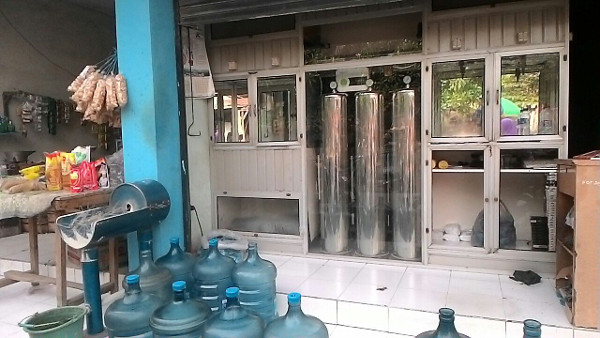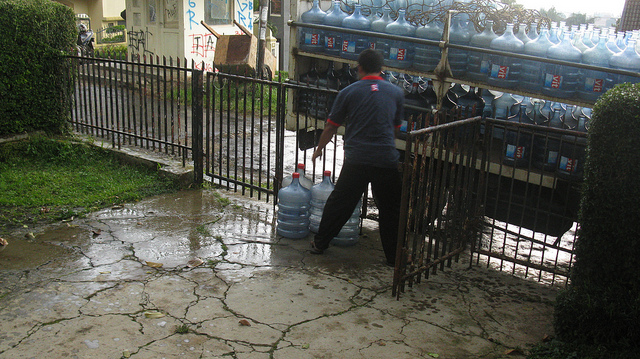RA Koesoemo Roekmi
In December 2015, 28 Bogor Agricultural University (IPB) students contracted hepatitis A. The Ministry of Health investigation found that ‘gallon water’ from the university canteens and student housing supplies was contaminated with hepatitis A. To make matters worse, diarrhoea-inducing E. coli bacteria was also present.
Gallons, the 19-litre bottled water containers sold across Indonesia, are supposed to be filtered and contaminant-free. So, how did these containers become so seriously contaminated? And what did the government do about it?
Water and the MDGs
In 2000, the United Nations member countries committed to combating significant issues in sustainable development in the form of eight Millennium Development Goals (MDGs). These goals addressed major issues including poverty and hunger, education, gender equality, child mortality and maternal health, and infectious diseases. In the context of sustainable development, access to clean water is considered a basic human right. Consequently, the seventh MDG was to ‘ensure environmental sustainability’ by cutting the proportion of people without access to safe drinking water and basic sanitation in half.
Indonesia had hoped to meet the target by increasing coverage of improved water, accessible through several means, including pipe water connection but excluding gallons. The target date for meeting all MDGs was September 2015, but not all targets were met. In 2016 world leaders launched a new agenda based on a list of 17 Sustainable Development Goals (SDGs) to be achieved by 2030. But in going forward, we need to understand whether the 2015 reports of target achievement truly mean that significant changes were made.
Bottled water counts
The 2014 Indonesian MDG report noted that in 1993, 38 per cent of the population had access to improved water. This was the starting point for calculating improvements. The Indonesian government had hoped to achieve 69 per cent access to improved drinking water by the 2015 MDG deadline. Initially, they had planned to accomplish this by increasing access to piped water services. History suggests, however, that this might be impossible. The population tends to grow faster in urban areas than the piped connections can keep up with.
Despite these difficulties, Indonesia was listed in the 2015 UN report among the countries that had achieved the MDG drinking water target. The report shows that 87 per cent of the population had access to improved sources, an increase from the 69 per cent target. The figure in the UN report is also different from that in the Indonesian government report, which claims that access was at 68 per cent. So how did Indonesia meet and exceed the target? And how can the reports, which are based on the same data, suggest such different results?
The most reasonable explanation relates to a 2011 shift in the way water access is measured. The shift meant that bottled water became countable as an improved drinking water source – if people also had access to other improved water sources for personal hygiene and cooking. With this latest definition, percentages show that Indonesia technically met and even exceeded the target.
However, this raises a new question: how safe can the bottled water really be compared to other improved drinking water sources (the ones people usually need to boil before drinking)? Would the students in Bogor have fallen ill if they had stuck to another source, even if it had been less convenient? How can water that makes people sick be counted towards achieving the MDG safe water target?

A water refill kiosk in Cikarang Pusat, Bekasi. (Credit: Asep Saepuloh)
Bottled water safety
Results from a 2012 Indonesian government demographic and health survey claimed that 42 per cent of urban households got their drinking water from gallons. By that time, this group had begun to rely heavily on gallons for drinking needs. After a one-time starter fee, refills cost Rp.15,000 for name-brand water and Rp.5000 for off-brand water at a refill kiosk. Naturally, the latter is more affordable for low-income families and has become a popular alternative to boiling water. Families purchase refills on the assumption that gallons are safe.
Refill kiosks use a system to filter pollutants. However, the method will only produce clean water if the original source is not too polluted and the filtration system is maintained. It seems that these goals are not easy for the kiosks to achieve. Research has produced samples from kiosks that contain coliform and E. coli bacteria.
As mentioned, hepatitis A was also found in gallons in the high-profile case of sick students at IPB.
A double-edged sword
Unfortunately, using gallon water to measure increased access is a double-edged sword. On the one hand, the statistics that include gallon water suggest that clean water access has improved for some of the population. There is no denying that increasing the supply of affordable bottled water would increase the number of families with access to water, with or without access to pipe connections. On the other hand, contamination will always be a risk considering the challenges facing the countless refill kiosks.
With this high dependence on potentially contaminated gallons, it is hard to believe the United Nations’ claim that 87 per cent of Indonesia’s population in 2015 had access to truly safe drinking water.
Future issues
Achieving the MDGs is not and will not be enough. Other unresolved water-related issues will impact the country for decades to come if targets are not met sustainably.
First, reliance on gallons creates enormous waste. The disposal of plastic into dumps or landfills is a huge problem, and Indonesia is the second-worst offending country in terms of dumping plastic into the ocean. Furthermore, ensuring that gallon water is an improved source would require strict quality monitoring, and the question remains as to whether the municipal governments could handle such work. The plastic and monitoring might be avoided entirely, however, if quality pipe connections are made available at a pace matching development and population growth, allowing residents to simply boil their water.
These issues are urgent since Indonesia is now preparing to fulfil its new commitment to the 2030 UN SDGs. It has committed to achieving sustainable water and sanitation goals, including universal and equitable access to safe and affordable drinking water for all, by 2030. As the country moves forward, we need to pay more attention to water quality, sustainability of sources, and fair access – these issues must be acknowledged by the government if it is to uphold the human rights of the Indonesian people.
RA Koesoemo Roekmi (radena@deakin.edu.au) is a PhD candidate in sustainable urban water management in the School of Engineering, Deakin University, Australia. She worked as a city planner in Bekasi District Planning Agency (Bappeda) from 2003 to 2014 and as head of the Natural Resources and Environment subdivision from 2011 to 2013.
